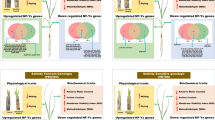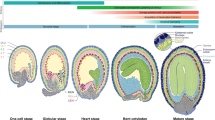Abstract
H2A.Z-containing nucleosomes have been found to function in various developmental programs in Arabidopsis (e.g., floral transition, warm ambient temperature, and drought stress responses). The SWI2/SNF2-Related 1 Chromatin Remodeling (SWR1) complex is known to control the deposition of H2A.Z, and it has been unraveled that ACTIN-RELATED PROTEIN 6 (ARP6) is one component of this SWR1 complex. Previous studies showed that the arp6 mutant exhibited some distinguished phenotypes such as early flowering, leaf serration, elongated hypocotyl, and reduced seed germination rate in response to osmotic stress. In this study, we aimed to investigate the changes of arp6 mutant when the plants were grown in salt stress condition. The phenotypic observation showed that the arp6 mutant was more sensitive to salt stress than the wild type. Upon salt stress condition, this mutant exhibited attenuated root phenotypes such as shorter primary root length and fewer lateral root numbers. The transcript levels of stress-responsive genes, ABA INSENSITIVE 1 (ABI1) and ABI2, were found to be impaired in the arp6 mutant in comparison with wild-type plants in response to salt stress. In addition, a meta-analysis of published data indicated a number of genes involved in auxin response were induced in arp6 mutant grown in non-stress condition. These imply that the loss of H2A.Z balance (in arp6 mutant) may lead to change stress and auxin responses resulting in alternative root morphogenesis upon both normal and salinity stress conditions.
Graphical Abstract





Similar content being viewed by others
Data Availability
The data published by Sura et al. [25] were obtained and used for gene ontology (GO) analysis and are available at https://doi.org/10.1105/tpc.16.00573.
References
Brahma, S., Udugama, M. I., Kim, J., Hada, A., Bhardwaj, S. K., Hailu, S. G., Lee, T. H., & Bartholomew, B. (2017). INO80 exchanges H2A.Z for H2A by translocating on DNA proximal to histone dimers. Nat Commun, 8, 15616. https://doi.org/10.1038/ncomms15616
Cai, H., Zhang, M., Chai, M., He, Q., Huang, X., Zhao, L., & Qin, Y. (2019). Epigenetic regulation of anthocyanin biosynthesis by an antagonistic interaction between H2A.Z and H3K4me3. New Phytologist, 221, 295–308. https://doi.org/10.1111/nph.15306
Choi, K., Kim, S., Kim, S. Y., Kim, M., Hyun, Y., Lee, H., Choe, S., Kim, S. G., Michaels, S., & Lee, I. (2005). SUPPRESSOR OF FRIGIDA3 encodes a nuclear ACTIN-RELATED PROTEIN6 required for floral repression in Arabidopsis. The Plant Cell, 17, 2647–2660. https://doi.org/10.1105/tpc.105.035485
Deal, R. B., Topp, C. N., McKinney, E. C., & Meagher, R. B. (2007). Repression of flowering in Arabidopsis requires activation of FLOWERING LOCUS C expression by the histone variant H2A.Z. The Plant Cell, 19, 74–83. https://doi.org/10.1105/tpc.106.048447
Fukaki, H., & Tasaka, M. (2009). Hormone interactions during lateral root formation. Plant Molecular Biology, 69, 437–449. https://doi.org/10.1007/s11103-008-9417-2
Huang, D. W., Sherman, B. T., Tan, Q., Collins, J. R., Alvord, W. G., Roayaei, J., Stephens, R., Baseler, M. W., Lane, H. C., & Lempicki, R. A. (2007). The DAVID Gene Functional Classification Tool: A novel biological module-centric algorithm to functionally analyze large gene lists. Genome Biology, 8, R183. https://doi.org/10.1186/gb-2007-8-9-r183
Julkowska, M. M., Hoefsloot, H. C., Mol, S., Feron, R., de Boer, G. J., Haring, M. A., & Testerink, C. (2014). Capturing Arabidopsis root architecture dynamics with ROOT-FIT reveals diversity in responses to salinity. Plant Physiology, 166, 1387–1402. https://doi.org/10.1104/pp.114.248963
Jung, C., Nguyen, N. H., & Cheong, J.-J. (2020). Transcriptional regulation of protein phosphatase 2C genes to modulate abscisic acid signaling. International Journal of Molecular Sciences, 21, 9517.
Khan, I. U., Ali, A., Khan, H. A., Baek, D., Park, J., Lim, C. J., Zareen, S., Jan, M., Lee, S. Y., Pardo, J. M., et al. (2020). PWR/HDA9/ABI4 complex epigenetically regulates ABA dependent drought stress tolerance in Arabidopsis. Frontiers in Plant Science, 11, 623. https://doi.org/10.3389/fpls.2020.00623
Kumar, S. V., & Wigge, P. A. (2010). H2A.Z-containing nucleosomes mediate the thermosensory response in Arabidopsis. Cell, 140, 136–147. https://doi.org/10.1016/j.cell.2009.11.006
Lademann, C. A., Renkawitz, J., Pfander, B., & Jentsch, S. (2017). The INO80 complex removes H2A.Z to promote presynaptic filament formation during homologous recombination. Cell Reports, 19, 1294–1303. https://doi.org/10.1016/j.celrep.2017.04.051
Leung, J., Merlot, S., & Giraudat, J. (1997). The Arabidopsis ABSCISIC ACID-INSENSITIVE2 (ABI2) and ABI1 genes encode homologous protein phosphatases 2C involved in abscisic acid signal transduction. The Plant Cell, 9, 759–771. https://doi.org/10.1105/tpc.9.5.759
Li, H., Yan, S., Zhao, L., Tan, J., Zhang, Q., Gao, F., Wang, P., Hou, H., & Li, L. (2014). Histone acetylation associated up-regulation of the cell wall related genes is involved in salt stress induced maize root swelling. BMC Plant Biology, 14, 105. https://doi.org/10.1186/1471-2229-14-105
Liu, W., Li, R. J., Han, T. T., Cai, W., Fu, Z. W., & Lu, Y. T. (2015). Salt stress reduces root meristem size by nitric oxide-mediated modulation of auxin accumulation and signaling in Arabidopsis. Plant Physiology, 168, 343–356. https://doi.org/10.1104/pp.15.00030
Livak, K. J., & Schmittgen, T. D. (2001). Analysis of relative gene expression data using real-time quantitative PCR and the 2(-Delta Delta C(T)) method. Methods, 25, 402–408. https://doi.org/10.1006/meth.2001.1262
Martin-Trillo, M., Lazaro, A., Poethig, R. S., Gomez-Mena, C., Pineiro, M. A., Martinez-Zapater, J. M., & Jarillo, J. A. (2006). Early in short days 1 (ESD1) encodes ACTIN-RELATED PROTEIN 6 (AtARP6), a putative component of chromatin remodelling complexes that positively regulates FLC accumulation in Arabidopsis. Development, 133, 1241–1252. https://doi.org/10.1242/dev.02301
Nguyen, C. T., Tran, G. B., & Nguyen, N. H. (2020). Homeostasis of histone acetylation is critical for auxin signaling and root morphogenesis. Plant Molecular Biology, 103, 1–7. https://doi.org/10.1007/s11103-020-00985-1
Nguyen, N. H., & Cheong, J. J. (2018). H2A.Z-containing nucleosomes are evicted to activate AtMYB44 transcription in response to salt stress. Biochemical and Biophysical Research Communications, 499, 1039–1043. https://doi.org/10.1016/j.bbrc.2018.04.048
Nguyen, N. H. (2020). Histone variant H2A.Z and transcriptional activators may antagonistically regulate flavonoid biosynthesis. AIMS Bioengineering, 7, 55–59. https://doi.org/10.3934/bioeng.2020005
Nguyen, H. N., Kim, J. H., Hyun, W. Y., Nguyen, N. T., Hong, S. W., & Lee, H. (2013). TTG1-mediated flavonols biosynthesis alleviates root growth inhibition in response to ABA. Plant Cell Reports, 32, 503–514. https://doi.org/10.1007/s00299-012-1382-1
Papamichos-Chronakis, M., Watanabe, S., Rando, O. J., & Peterson, C. L. (2011). Global regulation of H2A.Z localization by the INO80 chromatin-remodeling enzyme is essential for genome integrity. Cell, 144, 200–213. https://doi.org/10.1016/j.cell.2010.12.021
Petricka, J. J., Winter, C. M., & Benfey, P. N. (2012). Control of Arabidopsis root development. Annual Review of Plant Biology, 63, 563–590. https://doi.org/10.1146/annurev-arplant-042811-105501
Smith, A. P., Jain, A., Deal, R. B., Nagarajan, V. K., Poling, M. D., Raghothama, K. G., & Meagher, R. B. (2010). Histone H2A.Z regulates the expression of several classes of phosphate starvation response genes but not as a transcriptional activator. Plant Physiology, 152, 217–225. https://doi.org/10.1104/pp.109.145532
Sun, L. R., Wang, Y. B., He, S. B., & Hao, F. S. (2018). Mechanisms for abscisic acid inhibition of primary root growth. Plant Signaling & Behavior, 13, e1500069. https://doi.org/10.1080/15592324.2018.1500069
Sura, W., Kabza, M., Karlowski, W. M., Bieluszewski, T., Kus-Slowinska, M., Paweloszek, L., Sadowski, J., & Ziolkowski, P. A. (2017). Dual role of the histone variant H2A.Z in transcriptional regulation of stress-response genes. The Plant Cell, 29, 791–807. https://doi.org/10.1105/tpc.16.00573
Suzuki, N., Bassil, E., Hamilton, J. S., Inupakutika, M. A., Zandalinas, S. I., Tripathy, D., Luo, Y., Dion, E., Fukui, G., Kumazaki, A., et al. (2016). ABA is required for plant acclimation to a combination of salt and heat stress. PLoS One, 11, e0147625. https://doi.org/10.1371/journal.pone.0147625
West, G., Inze, D., & Beemster, G. T. (2004). Cell cycle modulation in the response of the primary root of Arabidopsis to salt stress. Plant Physiology, 135, 1050–1058. https://doi.org/10.1104/pp.104.040022
Willige, B. C., Zander, M., Yoo, C. Y., Phan, A., Garza, R. M., Trigg, S. A., He, Y., Nery, J. R., Chen, H., Chen, M., Ecker, J. R., & Chory, J. (2021). PHYTOCHROME-INTERACTING FACTORs trigger environmentally responsive chromatin dynamics in plants. Nature Genetics, 53, 955–961. https://doi.org/10.1038/s41588-021-00882-3
Xiong, L., Wang, R. G., Mao, G., & Koczan, J. M. (2006). Identification of drought tolerance determinants by genetic analysis of root response to drought stress and abscisic acid. Plant Physiology, 142, 1065–1074. https://doi.org/10.1104/pp.106.084632
Zolla, G., Heimer, Y. M., & Barak, S. (2010). Mild salinity stimulates a stress-induced morphogenic response in Arabidopsis thaliana roots. Journal of Experimental Botany, 61, 211–224. https://doi.org/10.1093/jxb/erp290
Acknowledgements
We would like to thank Prof. Ilha Lee (Seoul National University, South Korea) for his kindness in providing the arp6 mutant. We sincerely appreciate Dr. Nguyen Minh Tan (UCLA, USA) for his critical reading and comments on the manuscript.
Funding
This work was supported by Ho Chi Minh City Open University.
Author information
Authors and Affiliations
Contributions
NHN designed and supervised the research. BHD and NHN performed the experiments. BHD and NHN wrote the manuscript. NTH and TDL read and commented on the manuscript. All authors gave final approval for publication and agree to be held accountable for the work performed therein.
Corresponding author
Ethics declarations
Conflict of interest
The authors declare no conflict of interest.
Ethical Approval
This study was performed on the model plant (Arabidopsis thaliana) and was not involved in human participants and/or animals.
Additional information
Publisher's Note
Springer Nature remains neutral with regard to jurisdictional claims in published maps and institutional affiliations.
The original article has been corrected to update affiliation 1.
Rights and permissions
Springer Nature or its licensor (e.g. a society or other partner) holds exclusive rights to this article under a publishing agreement with the author(s) or other rightsholder(s); author self-archiving of the accepted manuscript version of this article is solely governed by the terms of such publishing agreement and applicable law.
About this article
Cite this article
Do, B.H., Hiep, N.T., Lao, T.D. et al. Loss-of-Function Mutation of ACTIN-RELATED PROTEIN 6 (ARP6) Impairs Root Growth in Response to Salinity Stress. Mol Biotechnol 65, 1414–1420 (2023). https://doi.org/10.1007/s12033-023-00653-x
Received:
Accepted:
Published:
Issue Date:
DOI: https://doi.org/10.1007/s12033-023-00653-x




